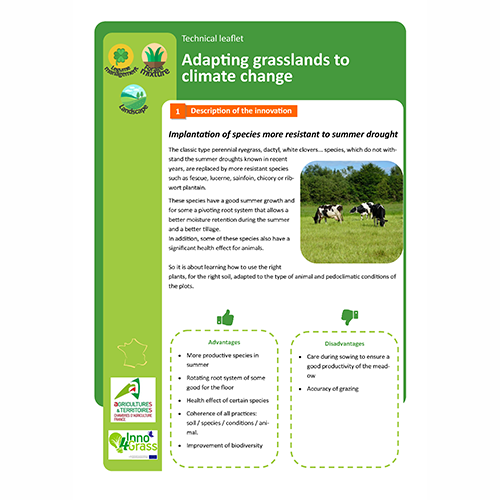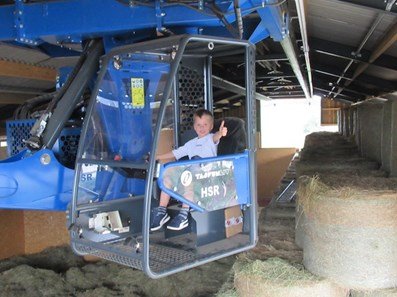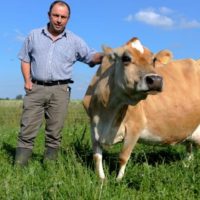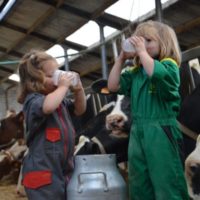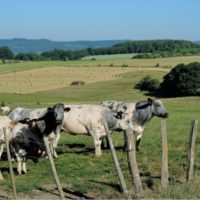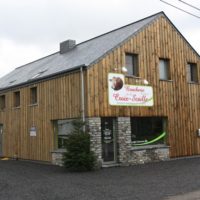Hay drying in barn, a deep change in farm management
Description
General context
The essential difference between normal milk and hay milk and its traditional character is that, as with the origins of milk production, the production of hay milk does not use fermented products.
While in mountain areas, silage has long been banned in some PDO cheese production areas, in western France the main motivation since 2000 has been the autonomy and production of quality hay in very hu-mid areas. The same motivation led to the setting up of a solar dryer in Wallonia for the first time in 2007.
Meanwhile, hay milk became a traditional European specialty guaranteed in 2016 un-der the impetus of an approach from Austria, followed by Italy and Germany.
In Austria, “hay” accounts for 15% of fluid milk. Germany started developing the indus-try in 2016, followed by France and Belgium in 2018.
Description of the innovation
To ensure a grass-fed diet without fermented products, stockbreeders must dry the grass to store it. Two possibilities can be considered:
- drying on the field thanks to the sun and the wind
- drying in the shelter only based on the circulation of dry air.
Field drying is highly dependent on climatic conditions. As a result, this hay is pro-duced with grass at heading stage, when it is easier to dry, but it is less rich in sugar and nitrogen. In addition, the action of UV rays and the tedder, which breaks the leaves, further degrade the energy and protein content.
Hay drying provides many benefits:
- Fast harvest;
- Increased harvest safety;
- Optimum crop harvest (high content of sugar and nitrogen);
- Very few losses at harvest;
- Reduction of complementary feed;
- Grassland improvement;
- Reduction of inputs;
- Decrease in veterinary fees and herd turnover rate;
- Mechanization of the harvest chain and reduction of working time;
- Obtaining quality milk: reduction of the presence of Clostridium botulinum and Lis-teria monocytogenes, excellent Ω6 / Ω3 ratio;
- Improved biodiversity (smaller mowing sites).
On the other hand, the drying of the grass requires important investments (equipped barn, crane fixed in the barn, fan, possibly dehumidifier or source of heat …). The cost of these installations is very variable depending on the equipment, the size and the share of self-construction. It ranges from 340 to 1,200 € per storable ton.
Faced with these costs, the farmer must adopt several strategies:
- Reduce the investment cost (public aid, self-construction, shared investment);
- Reinforce the added value of the investment: use drying for other products (wood, grains, aromatic herbs) and/or selling high quality hay (e.g. dried alfalfa);
- Reduce operating costs (dried hay reduces supplements, veterinary fees);
- Increasing the value of products: milk of differentiated quality and cheese pro-cessing. Producers of hay milk can obtain a gain of 0,05 to 0,10 euros per litre (and up to 0,3 € per litre for cheese sector).
- Get premiums for the protection of biodiversity (in Germany, hay producers re-ceive from 80 to 100 € per ha of grassland).
Results obtained with the adoption of the innovation
In Wallonia:
- An association of hay producers and cheese makers was created in 2018 to facilitate access to drying and support the “hay milk” sector.
- The number of drying installations is gradually increasing: 1 installation in 2007, 3 in 2016, 6 in 2018 and as many projects are under study.
- Investment aid has been available for an agricultural drying hall since 2018.
- A certification body assigns the STG label since 2018.
- The cheese quality of hay milk is now known by professionals:
- A young cheese maker has won 3 excellence awards in 2018 with very little experi-ence, but using hay milk.
- A cheese factory was created in 2019 to produce hay milk cheese.
Two types of stockbreeders may be interested in drying hay:
- Breeders looking for maximum feed autonomy on the farm.
These highly resilient systems are of particular interest from the economic point of view, the organization of work and the environment. Organic farmers often engage in this orientation or become organic producer very quickly once engaged. - Breeders who want to maintain high milk productivity with great intensi-fication levels, while reducing the share of maize silage in the ration.
In this case, the goal is to enhance protein autonomy. In general, they should not expect a production higher than 8,000 l per year per cow with hay rations.
In addition, a breeder wishing to feed his cattle with ventilated hay must pre-pare his project 2 to 3 years in advance:- 1 to 2 years for the visit to breeders already equipped with a dryer, for the adaptation of the herd, the organization of the parcels, the arrange-ment of the barns and stables, the search of the suppliers of material, the research on the valorization of milk;
- 6 to 12 months to the control and installation of the dryer.
Then, it will still take a year to master his installation.
And after?
The happiness of working in a healthy environment, conducive to the well-being of cows (or sheep or goats), with a greatly simplified workload in winter.
Future prospects
- Wallonia has yet to develop the market for products processed from hay milk.
- Networking at the European level is to be promoted: the Austrians and the Swiss are already working together. Belgians have contacts with German and French producers.
Additional information
| Domains of innovation | forage conservation technique |
|---|---|
| Main types of animal | beef cattle, dairy cattle, dairy goats, dairy sheep, meat sheep |
| Country | Belgium |
| Product type | Technical leaflet |
| Language | English, French |
